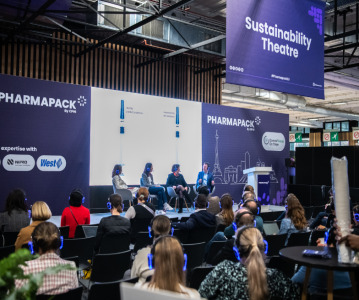Women in Pharma: C-Suite Journeys in Leading Diversity
.png)
In this CPHI Milan special of our monthly series, we sit down with our panel of C-suite executives speaking on the ‘Leading with Diversity: The CEO Journey’ panel at this year’s show.
We spoke with Mahmoud Assy (Eufonia Diversity), Christina Smolke (Antheia), Federica Fraschetti (MSD), and Emma Banks (Ramarketing & PR Ltd) to discuss the importance and challenges of leading diversity initiatives and influencing transformative strategies to foster a culture of DE&I in the pharmaceutical industry.
1. Why is it important to discuss diversity in leadership positions for pharma?
Fraschetti: It can improve decision-making and foster innovation by bringing a variety of perspectives, experiences, and ideas at the table at an executive level, leading to more innovative and effective solutions. In the pharmaceutical industry I think that innovation is particularly crucial in developing solutions to complex health challenges and uncovering unmet medical needs. At the core of the Pharmaceutical industry is the patient, comprising extremely diverse groups of people. A diverse leadership team is more likely to understand cultural backgrounds and financial/access disparities, ensuring the development of more effective treatments accessible to all populations. Pharmaceutical companies operate in a global market and having diverse leaders who understand different cultural and regional nuances can help companies better position themselves in international markets.
Assy: It's crucial to discuss diversity in leadership because the decisions made at the top profoundly influence not just the direction of a company but also the lives of countless patients. When leadership reflects a variety of backgrounds and perspectives, the company is better equipped to understand and serve the diverse needs of its global patient base. In the pharma industry, this diversity is more than a nice-to-have; it’s a necessity for developing inclusive healthcare solutions that resonate with and benefit everyone, not just a narrow demographic. By embracing diversity in leadership, we ensure that the products and strategies we create address the complexities of real-world patient populations, ultimately leading to better health outcomes while fostering greater trust and innovation.
Banks: A decent amount of research shows the importance of diversity at the leadership level and throughout organisations. It can enhance collaboration, innovation, creativity, decision-making, thinking, and ultimately performance (results and financial). It just makes sense.
Though the industry has a reputation for being white- and male-dominated in senior positions, it could be seen as a barrier to attracting and retaining the best talent at all levels of a company. On top of that (though at arms-length), recruiting diverse populations into clinical trials might also be adversely impacted by the lack of diversity at the top table - unconscious bias is real and has an influence on the decisions being made at the trial design stage.
Smolke: Our industry exists to improve the health and well-being of diverse populations worldwide. If the people leading this industry do not reflect that diversity, then understanding the diverse needs and unique challenges of the communities we’re trying to help will be an uphill battle. A more inclusive pharmaceutical industry will foster a deeper understanding of varied patient experiences – whether it's addressing disparities in global access to essential medicines or offering culturally responsive care. No one group has a monopoly on good ideas, so we need to create more opportunities for problem-solvers of all backgrounds to lead the constant evolution and innovation this industry requires. With a more nuanced sense of healthcare challenges across demographics, we can improve health outcomes for more people.
2. As leaders in the pharmaceutical industry, how have you worked to prioritise diverse hiring along with your other business objectives?
Fraschetti: Setting measurable DEI goals and integrating them in the overall KPIs of the organisation helps to diversify recruitment channels, as well as partnering with universities, professional organisations, and making a broader use of social media. This ensures that positions reach a broader range of candidates. Also, implementing DE&I Principles in the hiring process by reducing bias in selecting candidates and setting up diverse interview panels vs. single interview.
Banks: As a marketing agency in the pharma and biotech supply chain, we certainly have some real strength of diversity based on gender (we have an all-female C-level team, and a leadership team that represents the percentage of women vs men in the business) but there is more we can do. Diversity is not just about what we can see but also what we can’t see. Being inclusive and curious about the people we attract is so important. Practically, perhaps a shift away from the CV/resume as the main tool to apply or review and a more holistic approach which removes some barriers to the standard approach to communication (mainly written) more challenging (video submissions, less on merit and more on capability and fit).
Smolke: Our HR and People team has done a great job of implementing recruitment policies and processes that ensure all candidates have a fair chance when applying to work at Antheia. Our interview process is highly structured, and our team members undergo interview training to ensure each candidate has an unbiased and consistent experience. We know that unstructured interviews tend to favour candidates who share similar backgrounds with interviewers, so it’s critical to standardise the process – clearly defining the role and responsibilities, asking each candidate the same set of questions, providing feedback to HR in an orderly and timely manner – to reduce bias. The hiring and recruitment policies we’ve established serve as an important foundation as Antheia scales, ensuring that we attract the best people for the job and build a diverse and inclusive workforce. As a CEO, co-founder, and a former professor, I know firsthand how challenging it can be to achieve the ambitious goals you set for your team with limited resources. We are proud of the work we’ve done to prioritise fair and equitable hiring practices, and we also look forward to taking on larger DEI&B (diversity, equity, inclusion, and belonging) initiatives in the future.
3. What are the main challenges when looking to increase workforce diversity?
Fraschetti: Unconscious bias from managers in hiring and promoting candidates similar to themselves in terms of cultural, professional, or educational background is still something to overcome. There is also a lack of diverse talent pipelines in fields where certain groups are historically underrepresented (i.e. women in STEM – Science, Technology, Engineering, and Math). The retention of diverse talent can also be an issue in cases where the culture of the company is not diverse enough and individuals from less represented groups may not feel supported, valued, or even be subject to harassment or microaggressions.
Assy: One of the main challenges in increasing workforce diversity is that the systems and processes we create were designed with a particular "ideal" candidate in mind, usually reflecting the majority group or group in power. This creates barriers for those who don’t fit that mold, making it difficult for them to navigate these systems. Unconscious bias can further compound these challenges, leading to hiring practices that unintentionally exclude diverse candidates. Moreover, there’s often a pipeline issue, where the criteria we use to evaluate potential hires don’t account for the diverse ways talent can be developed and expressed. Addressing these challenges requires a fundamental rethinking of our systems to ensure they are inclusive by design, not by exception.
Banks: There are obvious reasons such as talent shortages but this may be driven by an inaccessibility to the subjects most important to the pharma industry such as STEM. This could also be because there is an expectation that candidates must have higher degree qualifications where other methods of attracting and developing talent may work just as effectively (apprenticeships as an example). Does the talent pool fully appreciate the opportunities available within the industry?
The culture or perception of culture as being diverse and inclusive or not will also have a big impact on talent attraction and retention. If an individual does not feel valued or understood then retention becomes challenging. We’ve already touched on leadership diversity as a key driver in attracting a diverse workforce. If you don’t see yourself represented in some capacity in the higher profile positions in a business, it can be a deterrent to apply for a job but there is also a challenge associated with how we get those individuals to those positions in the first place. Progress is slow.
There are also challenges associated with the global nature of the industry and how diversity is perceived across countries and finally how we are measuring the impact of diversity in our workforce such as defining the right metrics and then committing to and sustaining the change, as it requires ongoing effort.
Smolke: One of the biggest workforce diversity challenges in the sciences is the historical lack of access to the field for underrepresented groups. Many women and people of colour have faced significant barriers to entry in STEM, leading to a smaller pipeline of talent with the advanced degrees or experience levels that many positions require in our industry, and when these folks are hired in the field, they may face day-to-day challenges associated with being “the only” person in their department or company from that group. If people don’t feel supported or a sense of belonging, companies will struggle to retain a diverse workforce.
This challenge is one of the main reasons our team has focused on engaging with students in our communities. We’ve worked with local schools and groups like MelanIn Science to host high school and college students from underrepresented backgrounds for lab tours and panel discussions with our employees. This year, we’re also proud to have several employees volunteering with the BioMADE mentorship program to introduce students to industrial biomanufacturing and help prepare them for a potential career in the field. Introducing STEM careers to young people who may not have as much exposure to our field is one of the ways we’re helping to nurture a more diverse talent pipeline over time. Our team enjoys sharing their own experiences and the students get an up-close look at what a career in science could mean for them. With a background in academia and as a parent of two young children, our work as a company to expose students to the sciences is something that I’m particularly proud of and am excited to do more of as we grow.
4. What are some actionable next steps for companies looking to foster and increase workplace diversity, equity, and inclusion?
Fraschetti: Based on the above, companies could consider the following:
-
Implement SMART (Specific, Measurable, Achievable, Relevant, Time-bound) goals for DEI and incorporate them in their business objectives
-
Monitor progress against the aforementioned goals
-
Conduct periodical DE&I audits of their workforce, according to company DE&I principles and goals
-
Implementing unconscious bias training
Assy: We can start by re-evaluating the design of our internal systems and processes. Are these systems built with diversity in mind, or are they perpetuating a narrow view of who can succeed? Leadership needs to be committed to this re-design, integrating DEI into every aspect of the business, from recruitment to product development. Using data to identify gaps and defininingkey areas of action like implementing inclusive mentorship programs, and regular DEI training. But beyond these actions, it’s about creating an environment where diverse perspectives are not just welcomed but actively sought out and integrated into decision-making processes, leading to systems, processes, products, and services that are truly inclusive.
Banks: There are a number of things that can be done but they take time and effort and require a real focus on making change. Expansion of talent pools - not looking in the same places, making job descriptions inclusive, removing the dependence on CVs, and making sure recruitment processes are blinded wherever possible. Working to mentor and support all staff but where appropriate create mentorship between diverse employees and senior team members, train people on DE&I initiatives and focus on leadership development.
Smolke: Whether your company is a startup or a multinational corporation, there are some foundational DEI&B policies and best practices that should be non-negotiables. Focusing on reducing bias in the recruitment and hiring process is a great place to start, alongside regular anti-discrimination and inclusion training for employees and executive leaders. It is also imperative to mitigate unconscious bias from the performance review process so that all employees have the same opportunity for career development and advancement. This is achieved through management training and calibration of all performance reviews once they are complete to ensure consistency. Cultivating a safe and inclusive workplace environment is essential for ensuring that a diverse workforce can thrive at your company. HR teams should also be proactive about tapping into more diverse talent pools beyond a company’s immediate vicinity. Offering more flexibility in where and how employees work can attract talent across the country or around the world. Studies have shown that women and people of colour are more likely to thrive in these environments, making flexible work an effective recruitment tool.
5. How can the wider pharmaceutical industry implement DE&I values and actions into their operations?
Fraschetti: Starting from R&D, pharmaceutical companies should incorporate diversity in their clinical trials design already, in terms of patient recruitment & community engagement. Companies should also promote talent development programs with the goal of enhancing talent pipeline for underrepresented groups.
Assy: The wider pharmaceutical industry can implement DE&I values by fundamentally rethinking how we design our systems, products and services. Historically, these have often been created with specific, narrow users in mind, which can alienate those who don’t fit that profile. To address this, companies should ensure that their clinical trials, for example, include diverse populations to produce results that are applicable to a broader range of patients. Furthermore, integrating DE&I into supply chain decisions by prioritizing partnerships with diverse suppliers can also contribute to a more inclusive industry. This systemic approach ensures that DE&I values are woven into the fabric of the industry’s operations, from research and development to the delivery of healthcare solutions.
Banks: We need to bake diversity into R&D and clinical trial design as a starting point. In the same way that employees want to see themselves represented at senior levels in a business they work in, patients also need to see themselves in clinical trials and also in a healthcare setting. We could of course do with some more industry-wide initiatives that encourage advocacy and collaboration. Industry-wide DE&I standards and best practices may be of value to those businesses that are smaller or have fewer resources available.
Smolke: We saw many companies make public commitments to DEI&B in 2020, but momentum has dwindled for a number of reasons, causing some companies to pull back and even cut these types of initiatives. If we want to foster an industry that reflects the diversity of the populations we serve, we must consistently stick to our commitments on equity, fairness, and belonging. Embedding a commitment to diversity in a company’s DNA means consistently reinforcing inclusivity at every level of the organisation, through every phase of growth, and in every season of difficulty.
6. What piece of advice would you give to other executives about hiring diversity?
Fraschetti: Make yourself appealing for a diverse candidate pool to apply; put focus on DE&I Core Values incorporating them as actionable items. This will create a reputation for a diverse and inclusive workplace that will boost diversity of your applicants.
Assy: If I could give one piece of advice to executives about hiring for diversity, it would be to design your hiring processes with inclusivity at the forefront. Broaden your search beyond traditional recruitment sources. This means actively seeking talent in non-traditional places, such as those promoting diverse talent. However, hiring diverse talent is just the first step; retaining that talent requires cultivating a workplace culture where inclusion is a priority and all employees feel valued, with equal opportunities for growth. As an executive, it's crucial to lead by example, modeling inclusive behavior and making diversity, equity, and inclusion a visible and integral part of your decision-making and leadership style.
Banks: Look beyond the obvious signs of diversity and find ways to limit unconscious bias and to champion diversity of thinking (culturally - this is key), and operate in an inclusive way and build metrics and measures that can show positive progress whilst also being clear about what is not acceptable, whether that be recruitment practices, leadership development and inclusion.
Smolke: The benefits are clear: without a diverse team, your company will lack the insights needed to fully understand and address the unique needs of its customers. Cultivating diversity in your hiring practices will invite new and different perspectives to your corporate strategy, ultimately leading to better solutions and a stronger business. But achieving true diversity is a long-term commitment – there are no overnight fixes. While there are baseline best practices with recruitment policies and hiring initiatives, these will only be successful if they are embedded within a comprehensive, strategic approach built on trust, empathy, and transparency.
Do you have a story about diversity in the pharmaceutical industry? Contact vivian.xie@informa.com to have your story featured on CPHI Online as part of our Women in Pharma series.
Related News
-
News A Day in the Life of Oncology Start-Up Co-Founder & CEO
This Women's month we are highlighting stories of women in the pharma industry (building on what we do every month to support women), so for the Day in the Life of we are speaking to Sharon Cunningham who is the Co-founder and CEO of Shorla On... -
News Women in Pharma: Manufacturing personal and team success
Our monthly Women in Pharma series highlights the influential lives and works of impactful women working across the pharmaceutical industry, and how the industry can work towards making the healthcare industry and workplace more equitable and inclusive... -
News Women in Pharma: Connecting accessible pharma packaging to patients – a Pharmapack Special
Throughout our Women in Pharma series, we aim to highlight how CPHI events encourage discussions around diversity, equity, and inclusion initiatives in the pharmaceutical industry. -
News Women in Pharma: Delivering on global access to medicines
Our monthly Women in Pharma series highlights the influential lives and works of impactful women working across the pharmaceutical industry, and how the industry can work towards making the healthcare industry and workplace more equitable and inclusive... -
News Women in Pharma: Our hopes for 2025 and beyond
Our last instalment for 2024 of the Women in Pharma series brings you messages direct from the Informa Markets CPHI team as they discuss the advice and insights they have carried throughout their roles working at CPHI, and what they hope to see for the... -
News Closing 2024 with Editors' picks of top articles from the past year
Coming to the end of 2024 and it’s certainly been a busy year, for CPHI and for the rest of the pharmaceutical and healthcare industry. Topics of conversation throughout the last 12 months have been varied, touching on the technical, to the polit... -
News Day in the Life of a Green Chief Financial Officer
Our latest look into the daily lives of the people behind the pharma community brings us to meet Juan Jose Piedra Galan, Global Financial Planning & Analysis Manager for Galderma, otherwise known as 'The Green CFO'. -
News Women in Pharma: Reflections from Behind the Scenes
In this instalment of our monthly series, the team that brings you the Women in Pharma series each month sits down for a heart-to-heart on what the series means to them, and how they hope to continue their work in the future.
Recently Visited
Position your company at the heart of the global Pharma industry with a CPHI Online membership
-
Your products and solutions visible to thousands of visitors within the largest Pharma marketplace
-
Generate high-quality, engaged leads for your business, all year round
-
Promote your business as the industry’s thought-leader by hosting your reports, brochures and videos within your profile
-
Your company’s profile boosted at all participating CPHI events
-
An easy-to-use platform with a detailed dashboard showing your leads and performance





.png)


